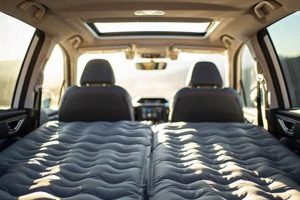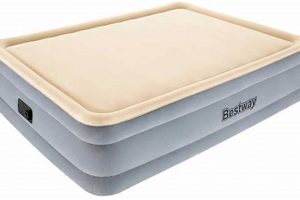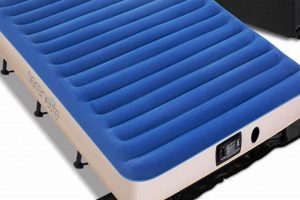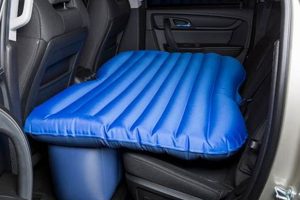An inflatable sleeping surface, often constructed of PVC or similar material, may be considered for transport on commercial airlines. These mattresses offer a portable and often economical bedding solution, particularly useful when traveling to locations with uncertain sleeping arrangements or when needing to accommodate extra guests. The feasibility of transporting such an item depends on its packed size and adherence to airline regulations.
Transporting such an item can offer several advantages. Individuals can ensure a comfortable sleeping environment regardless of the available lodging. This can be especially valuable for individuals with specific health needs or preferences regarding mattress firmness and support. Historically, travelers have sought methods to improve sleep quality while away from home, and inflatable mattresses represent a modern iteration of this pursuit, offering a balance of portability and comfort.
Regulations surrounding baggage dimensions and weight limitations are the primary considerations when determining whether this sleeping solution can be accommodated during air travel. Subsequent sections will detail specific airline policies, packing strategies, and potential restrictions related to carrying such an item onboard an aircraft.
Guidance for Air Mattress Transport
The following provides practical advice for individuals intending to travel with an inflatable mattress, ensuring a smoother and more compliant airport experience. Careful planning and adherence to airline policies are crucial for successful transport.
Tip 1: Consult Airline Baggage Policies: Prior to travel, review the specific baggage dimensions and weight restrictions imposed by the operating airline. Websites or customer service representatives are valuable resources for obtaining this information.
Tip 2: Measure Packed Dimensions: Once deflated and packed, accurately measure the length, width, and height of the mattress. Ensure these dimensions fall within the airline’s permissible carry-on or checked baggage limits.
Tip 3: Weigh the Packed Mattress: Using a luggage scale, determine the total weight of the packed air mattress. Avoid exceeding the airline’s weight allowance to prevent incurring additional fees.
Tip 4: Consider a Vacuum Compression Bag: Utilize a vacuum compression bag to minimize the mattress’s packed size. This can significantly reduce bulk and increase the likelihood of compliance with baggage restrictions.
Tip 5: Pack Separately if Necessary: If the mattress exceeds carry-on limits, pack it as checked baggage. Employ protective packaging to mitigate potential damage during handling.
Tip 6: Account for Inflation Device: If an electric pump is required to inflate the mattress, confirm that it is permitted by the airline and appropriately packed, adhering to restrictions on lithium batteries, if applicable.
Tip 7: Prepare for Security Screening: Be prepared to remove the air mattress from its packaging for inspection during security screening. Allow ample time for this process to avoid delays.
Adhering to these guidelines will minimize potential issues at the airport and facilitate the successful transport of the inflatable sleeping surface. Proper preparation is key to a stress-free travel experience.
Subsequent sections will address alternative sleeping solutions and considerations for purchasing travel-friendly mattresses.
1. Airline baggage policies
Airline baggage policies directly govern the permissibility of transporting an inflatable sleeping surface on a commercial flight. These policies establish parameters regarding size, weight, and composition of items allowed as carry-on or checked baggage, thereby dictating whether such mattresses are accepted for transport.
- Size Restrictions
Airlines impose limitations on the linear dimensions (length + width + height) of carry-on baggage. If, when deflated and packed, an inflatable mattress exceeds these dimensions, it cannot be brought into the cabin and must be checked. This may require adherence to further restrictions and potential fees.
- Weight Limits
Both carry-on and checked baggage are subject to weight restrictions. Surpassing these limits incurs overweight baggage fees. The weight of an inflatable mattress, combined with its packaging and inflation device (if applicable), must fall within the airline’s stipulated weight allowance to avoid additional charges.
- Restricted Items
Certain components of an inflatable mattress or its inflation device may be classified as restricted items. For example, some airlines prohibit the transport of specific types of pumps or require lithium batteries to be carried in the cabin. Understanding these restrictions is crucial for compliance.
- Liability and Damage
Airlines often have limited liability for damage to checked baggage. Transporting a valuable or fragile inflatable mattress as checked baggage carries the risk of damage during handling. Travelers should consider this risk when deciding whether to transport the item and ensure appropriate protective packaging is utilized.
The impact of airline baggage policies on the ability to travel with an inflatable sleeping surface is significant. Non-compliance with size, weight, or restricted item regulations can result in denied boarding of the item, additional fees, or even confiscation. Thoroughly reviewing and adhering to the specific policies of the airline is paramount for a successful transport. These policies are constantly evolving, thus constant vigilance is needed.
2. Size and weight limits
The physical dimensions and mass of a deflated and packed inflatable mattress are primary determinants of its acceptability for air travel. Airline regulations governing baggage size and weight directly impact the ability to transport such an item either as carry-on or as checked luggage.
- Carry-On Restrictions and Air Mattresses
Carry-on baggage restrictions are stringent, often limiting the linear dimensions (length + width + height) of permissible items. An inflatable mattress exceeding these dimensions, even when deflated and compressed, will not be allowed in the cabin. The consequence is mandatory checking of the item, potentially incurring fees and requiring adherence to additional checked baggage regulations.
- Checked Baggage Limitations and Air Mattresses
Checked baggage is also subject to size and weight limits, though often more lenient than carry-on allowances. An oversized or overweight inflatable mattress will result in excess baggage charges. These fees can
be substantial, potentially exceeding the cost of the mattress itself. Furthermore, airlines may refuse to transport items exceeding maximum allowable dimensions or weights. - The Impact of Compression on Dimension and Weight
Effective compression techniques, such as using vacuum-sealed bags, can significantly reduce the packed size of an inflatable mattress. This may enable the item to meet carry-on or checked baggage size restrictions. However, compression does not alter the item’s weight; therefore, careful attention must still be paid to weight limits.
- Discrepancies Among Airline Policies
Baggage size and weight limits vary significantly among different airlines. What is permissible on one airline may be prohibited on another. Therefore, it is imperative to consult the specific baggage policies of the airline being used before attempting to transport an inflatable mattress. This avoids unexpected complications and fees at the airport.
The interplay between size and weight limitations and airline policies directly influences whether an inflatable sleeping surface can be accommodated on a flight. Understanding these restrictions and employing appropriate packing strategies are crucial for travelers seeking to bring such items on their journey. Failure to comply can lead to added costs, delays, or outright rejection of the item.
3. Packing efficiency
Packing efficiency serves as a critical determinant in the feasibility of transporting an inflatable mattress on an aircraft. The relationship is directly proportional: improved packing efficiency increases the likelihood of compliance with airline baggage regulations, thus enhancing the probability of successful transport. An inadequately packed mattress will likely exceed size and/or weight limits, leading to additional fees or outright denial of transport. For instance, an uncompressed, rolled air mattress might easily surpass carry-on size restrictions, whereas employing a vacuum-compression bag can reduce its volume significantly, potentially enabling its acceptance as carry-on luggage. The act of compressing and strategically arranging the mattress alongside other belongings can reduce its footprint, facilitating acceptance as luggage.
Further augmenting packing efficiency involves meticulous selection of accompanying items and efficient space utilization within the suitcase or travel bag. Heavier items should be placed near the wheels of rolling luggage to maintain balance and prevent tipping, while lighter, compressible articles can be used to fill voids around the mattress. Every cubic inch of available space should be strategically allocated. Maximizing packing density reduces the overall luggage dimensions and maintains the structural integrity during handling. These steps ensure that the air mattress and its companions are both protected and compliant with size constraints.
In summation, packing efficiency functions as a pivotal enabler for transporting an inflatable mattress via air travel. By employing compression techniques, strategic item placement, and meticulous space utilization, travelers can optimize luggage dimensions and minimize weight, thereby increasing the likelihood of adherence to airline regulations. The challenge lies in achieving maximum compression without compromising the integrity of the air mattress or exceeding weight limitations. Failure to prioritize packing efficiency significantly diminishes the prospect of successfully bringing an inflatable mattress on a plane, leading to avoidable expense or inconvenience.
4. Security regulations
Security regulations governing air travel significantly influence the transport of inflatable mattresses. These regulations aim to prevent prohibited items from entering aircraft and ensure passenger safety, directly affecting how such items are scrutinized during the screening process.
- Inspection Procedures and Air Mattresses
Inflatable mattresses, whether carried on or checked, are subject to inspection by security personnel. This may involve visual examination, X-ray scanning, or physical probing to ensure no prohibited items are concealed within the mattress. The complexity of these inspections can vary based on security directives and the discretion of the screening officers. The presence of metallic components, such as valves or integrated pumps, may trigger further scrutiny.
- Potential for Delay and Inconvenience
The inspection of an inflatable mattress can potentially lead to delays at security checkpoints. Passengers should be prepared to remove the mattress from its packaging for inspection and allow ample time for this process. Security personnel may require the mattress to be partially or fully deflated to facilitate thorough examination, potentially causing inconvenience to the traveler.
- Restrictions on Inflation Devices
Security regulations may impose restrictions on the transport of inflation devices, particularly those containing lithium batteries. Electric pumps powered by lithium batteries may be subject to specific regulations regarding battery capacity and packaging. Passengers must comply with these restrictions to avoid confiscation of the inflation device.
- International Variations in Security Protocols
Security protocols can vary significantly between airports and countries. Travelers should be aware that an inflatable mattress accepted at one airport may be subject to stricter scrutiny or even prohibited at another. It is advisable to consult the security regulations of both the departure and arrival airports to avoid unexpected complications.
Compliance with security regulations is essential for the successful transport of an inflatable mattress via air travel. Failure to adhere to these regulations can result in delays, confiscation of the item, or even denial of boarding. Passengers should familiarize themselves with the applicable security protocols and be prepared for thorough inspection of their mattress at security checkpoints.
5. Inflation device restrictions
The ability to transport an inflatable mattress on a plane is directly contingent upon adherence to restrictions governing inflation devices. These restrictions, imposed by both airlines and aviation security agencies, dictate the permissibility of carrying pumps or other mechanisms used to inflate the mattress. A primary concern revolves around devices containing lithium batteries, as these are subject to strict regulations due to potential fire hazards. Certain battery types or watt-hour ratings may be prohibited altogether, or require carriage within the cabin rather than in checked baggage. Furthermore, manual pumps are generally permissible but may still be subject to inspection to ensure they do not pose a security risk. Failure to comply with these restrictions can result in confiscation of the inflation device, rendering the mattress unusable upon arrival.
Practical examples illustrate the significance of these restrictions. Consider a traveler attempting to transport an air mattress with an integrated electric pump containing
a non-compliant lithium battery. Airport security would likely confiscate the pump, negating the usefulness of bringing the air mattress. Alternatively, a traveler using a manual foot pump may face scrutiny during security screening, requiring them to demonstrate its intended use. A lack of understanding or preparedness regarding inflation device restrictions can disrupt travel plans, leading to inconvenience and expense. Therefore, researching and adhering to current airline and security guidelines is crucial.
In conclusion, the feasibility of transporting an air mattress on a plane is not solely dependent on the mattress itself but is inextricably linked to regulations surrounding inflation devices. Compliance with these regulations ensures a smoother travel experience, preventing potential delays, confiscations, and the overall inability to utilize the air mattress at the destination. Staying informed and proactive in this area is vital for travelers relying on inflatable mattresses for comfortable sleeping arrangements during their journey.
6. Potential damage risk
The inherent susceptibility of inflatable mattresses to damage during air travel constitutes a significant consideration when assessing their suitability for transportation. The nature of air travel, involving handling by multiple personnel and exposure to varying environmental conditions, elevates the risk of compromising the structural integrity of the item.
- Puncture Vulnerability
The primary material of construction, typically PVC or a similar polymer, is vulnerable to punctures from sharp objects. During transit, the mattress may come into contact with items in the cargo hold or be subjected to rough handling, increasing the likelihood of damage. A puncture renders the mattress unusable, negating its intended purpose.
- Abrasion and Tears
Repeated friction against other surfaces during transport can cause abrasion and tears in the mattress material. This is particularly relevant if the mattress is not adequately protected within robust packaging. Such damage may not immediately render the mattress unusable but can compromise its long-term durability and lead to air leaks.
- Valve Damage
The inflation valve is a critical component that is susceptible to damage from impact or pressure. A damaged valve can prevent proper inflation or cause air leakage, rendering the mattress ineffective. Protection of the valve during transit is therefore essential.
- Temperature and Pressure Effects
Exposure to extreme temperatures or pressure variations within the cargo hold can potentially damage the mattress material. Expansion and contraction due to temperature changes can stress seams and weaken the overall structure. While modern materials are designed to withstand some variation, prolonged exposure to extreme conditions can still pose a risk.
Considering these potential sources of damage, the decision to transport an inflatable mattress via air travel necessitates a careful evaluation of risk versus benefit. Employing protective packaging, such as a hard-sided suitcase or reinforced bag, can mitigate some of these risks. However, the inherent vulnerability of the item remains a factor that travelers must weigh against the convenience and comfort offered by an inflatable sleeping surface.
7. Alternative bedding options
The decision of whether to transport an air mattress on a plane is intrinsically linked to the availability and suitability of alternative bedding options at the destination. When evaluating the practicality of including an inflatable mattress in travel plans, individuals must consider the potential for readily accessible and comfortable alternatives. These may include traditional mattresses provided by hotels or rental accommodations, rollaway beds, or even sleeping bags coupled with suitable padding. The perceived need for the air mattress diminishes proportionally with the availability and quality of these substitutes. For instance, a traveler booking a stay in a reputable hotel chain may find the standard mattress adequate, negating the necessity of transporting a supplementary sleeping surface. Conversely, someone visiting a friend or relative with limited guest room provisions might prioritize bringing an air mattress to ensure a comfortable night’s sleep.
The choice of alternative bedding also bears economic implications. Transporting an air mattress as checked baggage often incurs additional fees, potentially exceeding the cost of renting a cot or purchasing a low-cost sleeping bag at the destination. Furthermore, the inherent risk of damage to the air mattress during transit must be weighed against the expense and convenience of alternative solutions. Consider a scenario where an individual pays $50 in baggage fees to transport an air mattress, only to discover upon arrival that the available bedding is acceptable or that a comfortable alternative can be rented for a similar or lesser amount. In such instances, the decision to transport the air mattress proves economically inefficient.
In summary, the consideration of alternative bedding options forms an integral component of the decision-making process surrounding air mattress transport. Factors such as the availability, comfort, cost, and potential damage risk associated with both the air mattress and alternative solutions must be carefully evaluated. A thorough assessment of these elements enables travelers to make informed choices aligned with their individual needs and circumstances, ultimately optimizing their travel experience.
Frequently Asked Questions
The following addresses common inquiries regarding the feasibility of transporting an inflatable sleeping surface as part of air travel.
Question 1: Is an air mattress generally permitted on commercial flights?
The permissibility of transporting an air mattress is contingent upon adherence to the specific baggage policies of the operating airline. Size, weight, and composition restrictions dictate whether the item can be accommodated as carry-on or checked baggage.
Question 2: What are the critical size limitations for transporting an air mattress as carry-on luggage?
Carry-on baggage restrictions are stringent, typically limiting the linear dimensions (length + width + height) of permissible items. An air mattress exceeding these dimensions, even when deflated and compressed, will not be allowed in the cabin.
Question 3: What is the protocol for packing an air mattress to maximize space efficiency for air travel?
Employing vacuum-sealed bags and strategic item placement can significantly reduce the packed size of an air mattress. This compression may enable compliance with carry-on or checked baggage size restrictions.
Question 4: How do security regulations affect the transportation of an air mattress?
Air mattresses, whether carried on or checked, are subject to inspection by security personnel. This may involve visual examination, X-ray scanning, or physical probing to ensure no prohibited items are concealed within the item.
Question 5: Are there restrictions on transporting pumps used to inflate air mattresses?
Inflation devices containing lithi
um batteries are subject to specific regulations regarding battery capacity and packaging. Non-compliance can result in confiscation of the inflation device.
Question 6: What are the potential risks of damage to an air mattress during air transport?
The primary material of construction is vulnerable to punctures, abrasion, and tears. Damage to the inflation valve is also a concern. Protective packaging can mitigate some of these risks.
Adherence to airline policies, efficient packing techniques, and understanding security protocols are essential for the successful transport of an air mattress. Failure to comply can lead to added costs, delays, or outright rejection of the item.
The following section presents a summary of key considerations regarding air mattress transport.
Conclusion
The preceding exploration of “can you take an air mattress on a plane” underscores the multifaceted nature of this query. The answer is not a simple affirmative or negative, but rather a conditional one deeply intertwined with airline policies, size and weight constraints, security regulations, and the potential for damage. Successful transport necessitates meticulous planning, adherence to specific airline guidelines, and a thorough understanding of prevailing security protocols. Furthermore, alternative bedding options should be carefully considered before opting to transport an inflatable mattress via air.
Ultimately, the decision to transport an air mattress on an aircraft requires a balanced assessment of feasibility, cost, and potential inconvenience. Travelers are strongly encouraged to proactively consult with their chosen airline regarding specific baggage restrictions and to prepare accordingly. Careful planning will minimize potential disruptions and optimize the overall travel experience.







